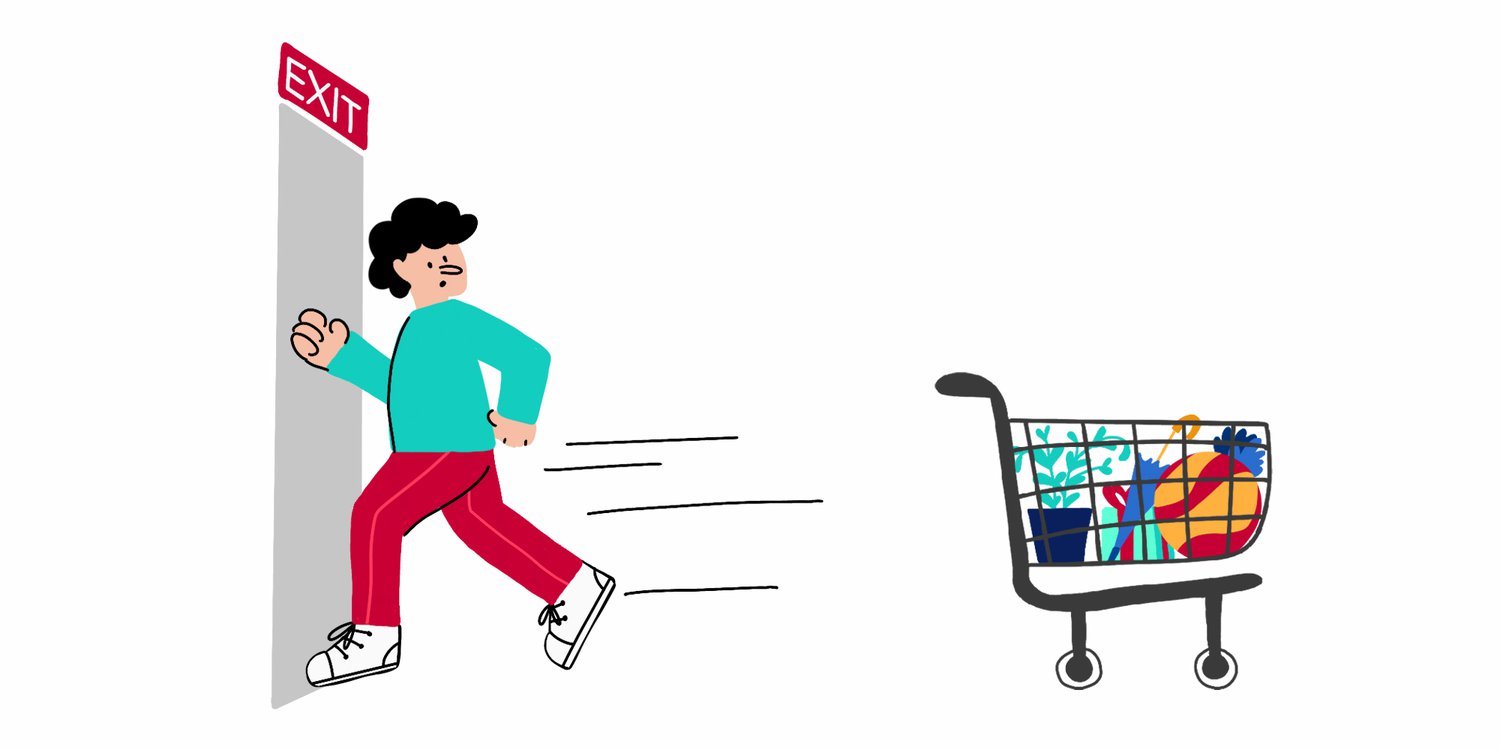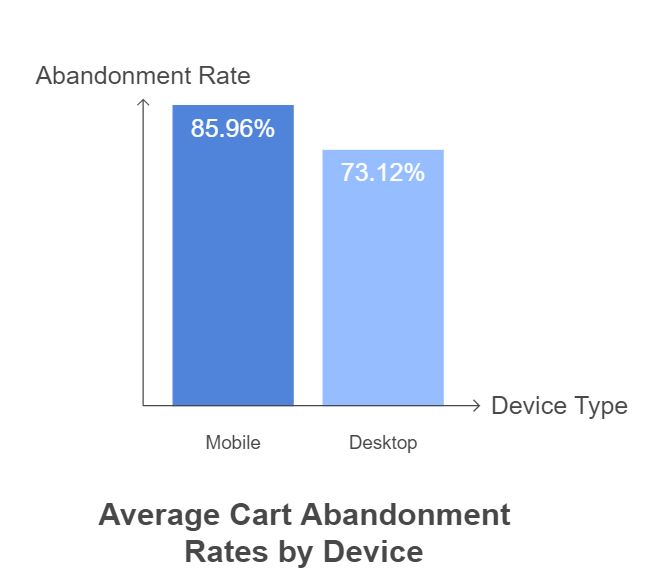- Research platform
Sources of information
Data analysis
Actions
- Solutions
For whom
Problems / Issues
- Materials
Materials
- About us
About us

Shopping cart abandonment is a common challenge facing online retailers, with nearly 70% of online shopping carts left unpurchased. Knowing why this happens is important to improve your online strategy and boost conversion rates. This blog post will look at how online shoppers behave and why they leave carts behind.
We will address different reasons that cause users to divert from their purchase, examine how cart abandonment affects revenue, and present ways to reduce this loss. For seasoned e-commerce experts or those new to online selling, this post offers insights to help turn abandoned carts into completed sales. Let us take a look at effective strategies and the role of customer experience to improve your conversion rates.
Shopping cart abandonment is when users add items to their online cart, yet do not finish the checkout. This leaves items in carts without purchases. This behavior plays a big role for eCommerce sites since it impacts both, sales and conversion rates.
To understand shopping cart abandonment, it’s important to note the difference from other actions like browse abandonment and checkout abandonment. Browse abandonment occurs when users visit a site, see products, but do not add them to cart. Checkout abandonment is when customers start, but do not finish their purchase. Knowing these differences help retailers adapt their strategies to the specific behaviors of users.
Additionally, many users engage in window shopping, where they browse products without the intent to purchase, contributing to high cart abandonment rates.
Statistics on shopping cart abandonment are significant, with rates exceeding 70% in many sectors. This high rate illustrates the problems eCommerce faces, as potential revenue is lost. Beyond direct sales losses, effects of shopping cart abandonment alter overall conversion rates and hurt consumer trust in brands. Analyzing the reasons behind it is needed to improve the checkout process and increase customer satisfaction.
When we look at the factors causing cart abandonment, it shows that addressing this problem is key for eCommerce growth. Next, we will review the reasons why users leave their shopping carts and how businesses can solve those issues.
Cart abandonment occurs when a customer adds items to their online shopping cart but fails to complete the purchase. This phenomenon can be attributed to various factors, such as unexpected shipping costs, a confusing checkout process, or a lack of trust in the brand. For online retailers, cart abandonment is a significant issue as it directly translates to lost sales and revenue. Understanding the reasons behind this behavior is crucial for developing strategies to mitigate its impact and enhance the overall shopping experience.
According to the Baymard Institute, the average shopping cart abandonment rate is a staggering 69.99%. This statistic reveals that nearly 70% of online shoppers abandon their carts before completing their purchase. While the abandonment rate can vary depending on the industry, niche, and business type, it remains a pervasive issue affecting many online retailers. These statistics underscore the importance of addressing cart abandonment to improve conversion rates and boost revenue.

Shopping cart abandonment remains a major issue for online stores. Understanding reasons why shoppers leave their carts without buying is vital. Doing so can improve user experience and boost conversion rates. Here are common reasons for cart abandonment.
Addressing these factors is key to reducing shopping cart abandonment. By making changes to enhance shopping experiences, retailers can improve satisfaction and increase conversion rates.
In the next section, we will look into shopping cart abandonment rate and its effects on online businesses.
Analyzing user behavior is crucial to understanding why customers abandon their carts. By examining the checkout process and identifying patterns and trends, online retailers can make data-driven decisions to improve the shopping experience and reduce cart abandonment. This involves using analytics tools to track customer interactions, from browsing to the final stages of the checkout process. By gaining insights into user behavior, retailers can pinpoint specific areas that need improvement and implement changes that enhance the overall shopping experience.
Understanding customer behavior is essential to reducing cart abandonment. Online retailers can leverage analytics tools to track various aspects of customer behavior, including browsing patterns, purchase history, and cart abandonment rates. By analyzing this data, retailers can identify areas for improvement and make informed changes to the checkout process. For instance, if data shows that customers frequently abandon their carts at a particular stage, it may indicate a need for a more streamlined and user-friendly checkout flow.
Identifying patterns and trends in customer behavior can help online retailers uncover the root causes of cart abandonment. For example, if a retailer notices a high abandonment rate at the shipping stage, it may be necessary to re-evaluate shipping options or pricing. By recognizing these patterns, retailers can make targeted changes to the checkout process, such as offering free shipping or simplifying the checkout steps. These adjustments can significantly reduce cart abandonment and increase sales, ultimately leading to a more successful online store.

Cart abandonment rate is a key metric for eCommerce, showing the percentage of users who add products to their carts but leave the site without buying. Recognizing this rate helps find areas where conversion rates can be improved.
Cart abandonments can fluctuate throughout the month, with higher rates often observed as paydays approach and during seasonal factors like holidays.
The average cart abandonment rate stands at around 69.57% across various sectors. This means about seven in ten potential customers do not complete their purchases. This fact shows how widespread shopping cart abandonment is in eCommerce.
There’s a significant gap in abandonment rates between mobile and desktop users. Mobile users have an average rate of about 85.96%, while desktop users average 73.12%. This disparity reveals issues mobile eCommerce faces. Addressing these concerns is essential to improving user experience.
It’s vital to analyze the data. By understanding why customers abandon carts, eCommerce can adjust strategies to effectively reduce rates and boost sales. Also, as we progress, looking at cart abandonment’s effect on revenue is essential for motivating effective strategies.
Shopping cart abandonment is a big problem for eCommerce firms. It cause loss of revenue that builds up quickly. Annually, around $18 billion in sales vanish from abandoned shopping carts. This amount show the need to grasp reasons behind abandonment and properly tackle them.
The effects of cart abandonment go beyond just losing sales. For eCommerce businesses, frequent cart abandonment hurts long-term growth and profits. When customers leave items without buying, they lose not only the current sale but also chances for future purchases from those shoppers. If ignored, this may lessen brand loyalty and stop repeat buying, hurting profit margins.
Additionally, fixing shopping cart abandonment can significantly boost total revenue. By using smart strategies to drop abandonment rates, companies change missed sales into completed sale, helping financial outcomes improve. For example, simplifying checkout steps, revealing shipping costs upfront, and having more payment methods can lessen cart abandonment and make a better shopping experience.
In conclusion, firms that see and address the challenges of shopping cart abandonment are in a good spot to raise profit and promote lasting success. Knowing these effects is critical for eCommerce businesses looking to survive in a competitive market.
It's important to discover effective ways to lessen shopping cart abandonment, which will enhance conversion rates and create a better scenario for businesses and buyers.
Understanding the significant financial effects of shopping cart abandonment is vital. Implement effective strategies to lessen this issue. Here are proven tactics for reducing shopping cart abandonment and boosting conversion rates.
One effective strategy is offer guest checkout options. When customers must create an account to complete a purchase, it can lead to frustration. Allowing guest purchases can make their experience smoother and encourage order completion.
Clear pricing transparency is also very important. Hidden fees or unexpected costs can drive customers away. It’s necessary that you display all pricing—like shipping, taxes, and extra fees—clearly during checkout. Surveys show 61% of consumers abandon their carts due to shipping cost surprises.
Simplifying the checkout page is essential. A complicated checkout can overwhelm customers. Cutting down on steps, pre-filling forms, and offering autofill can improve experience and reduce abandonment rates.
Effective checkout pages should guide users through the purchasing process with strong calls to action and clear next steps to prevent cart abandonment.
Incorporate trust signals like security badges and money-back guarantees to ease consumer concerns. Visible trust indicators can ease hesitation. About 17% of shoppers abandon carts due to security worries.
Finally, using exit-intent pop-ups and abandoned cart emails can help recover lost sales. These reminders can offer discounts or incentives to encourage purchases. Studies show sending abandoned cart emails can recover up to 30% of sales.
By following these strategies, businesses can effectively lower shopping cart abandonment rates and enhance revenue opportunities. It’s also important to explore how innovative solutions such as YourCX can combat shopping cart abandonment.
The issue of shopping cart abandonment is related to customer experience. YourCX is a strong partner for eCommerce businesses. By using advanced analytics, YourCX shows customer behaviour throughout their shopping journey. This information helps pinpoint when users leave their carts and why.
YourCX focuses on real customer feedback. Using surveys and feedback, YourCX gets insights straight from users, helping businesses see their wants and issues. If users mention long checkout flows, retailers can change these steps. Adapting to customer needs is critical since 69% of users abandon their carts due to complex checkouts.
YourCX creates solutions for eCommerce platforms, improving shopping experiences. Strategies based on real-time feedback help retailers personalize and make navigation easier. Businesses can also send reminders and recovery emails to reach customers who left items behind. This can lower their shopping cart abandonment rates.
In the end, using YourCX in eCommerce not only reduces shopping cart abandonment but also encourages ongoing upgrades. By monitoring the customer journey using insights, businesses can make a more user-friendly place, boosting conversions and loyalty.
Summarizing the facts about shopping cart abandonment shows that knowing user behaviour is key to eCommerce success. We looked into the many reasons users abandon their carts, such as high costs, tough checkout steps, unclear return rules, and low trust. Cart abandonment impacts revenue, showing the need to fix these problems quick. Optimizing checkout flows by reducing steps and simplifying forms can significantly reduce cart abandonment rates.
You can lower shopping cart abandonment rates by making the buying process simple, improving support, and enhancing your site’s usability. Better processes lead to happier customers and increase sales overall. Offering diverse payment options can also enhance customer satisfaction and reduce cart abandonment by providing security and flexibility.
Take these strategies seriously and get started now. Review your checkout steps, collect user opinions, and keep adjusting to what customers want. Overcoming shopping cart abandonment needs constant effort and fresh ideas. With the best tactics, you can change potential losses into real sales, creating a better shopping time for your customers.
Copyright © 2023. YourCX. All rights reserved — Design by Proformat